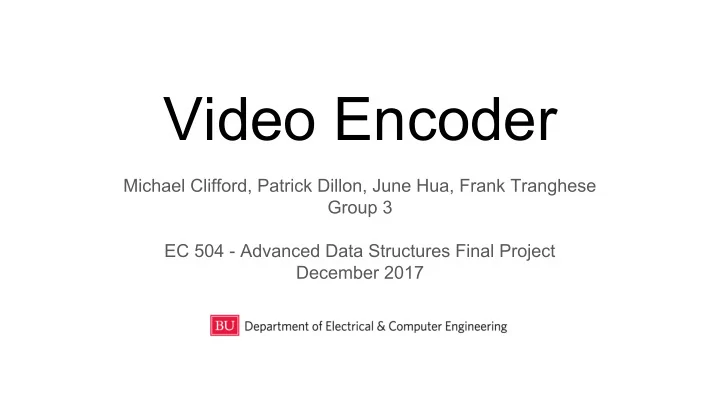

Video Encoder Michael Clifford, Patrick Dillon, June Hua, Frank Tranghese Group 3 EC 504 - Advanced Data Structures Final Project December 2017
Video Compression ● The process of concatenating still images into moving video. ● For an image of 1920 x 1800 pixels with 24 bits per pixel, played at 30 frames per second: Over 2000 Mbps! ● Video compression algorithms increasingly necessary to provide services like YouTube, Skype, and other video sharing APIs.
Problem Statement ● Encode up to 100 JPEG images (of the same dimensions) into one encoded file in under 5 minutes. ● File size no more than the sum of the individual images ● Ability to play back at least 10 images per second.
Overall Design
Discrete Cosine Transform Discrete Cosine Transform Formula 8 x 8 DCT on JPG https://en.wikipedia.org/wiki/Discrete_cosine_transf orm#/media/File:DCT-8x8.png Khedr and Abdelrazek. Image Compression using DCT upon Various Quantization . International Journal of Computer Applications (0975–8887)Vol. 137 No.1, March 2016 Raid, AM et al. Jpeg Image Compression Using Discrete Cosine Transform - A Survey . IJCSES. Vol.5, No.2, April 2014
Quantization ● JPEG standard quantization matrix ● Vary quantization matrix scale to change quality Quantization Matrix Khedr and Abdelrazek. Image Compression using DCT upon Various Quantization . International Journal of Computer Applications (0975–8887)Vol. 137 No.1, March 2016
Quantization Scale Factor QScale = 1 QScale = 5 QScale = 10
Inverse Discrete Cosine Transform IDCT Raid, Khedr, El-dosuky, and Ahmed.. Jpeg Image Compression using Discrete Cosine Transform - A Survey . International Journal of Computer Science & Engineering Survey (IJCSES) Vol. 5 No.2, April 2014
DCT and Quantization Time Complexity Θ(n 2 ), where n = number of pixels in a single image For m images, m << n ⇒ Runtime: Θ(n 2 ) ● m ~ n ⇒ Runtime: Θ(mn 2 ) ● ● m >> n ⇒ Runtime: Θ(m)
Bitstream Encoding/Decoding: the .group3 filetype After compression, the bytes of each image are appended into a .group3 file.
Features ● Takes .jpeg, .bmp, .png, and .gif (static) ● User can change quality of the output video at the cost of file size. ● Three real-time video transforms ○ Grayscale ○ Color Inversion ○ Gaussian Blur ● Option for MPEG-2 compliant output.
File Input Types and BufferedImage ● Initial images converted to an ArrayList<BufferedImage> ● BufferedImage is a built in Java.awt type that supports JPEG, BMP, PNG, and GIF file types. ● All code designed around this data structure choice. Input Images ArrayList<BufferedImage>
Quality Change ● Uses Java built-in convolution operator for BufferedImage call ConvolveOp. ● Convolves images with kernels that average groups of nearby pixels to the same value. ● Making neighboring colors similar reduces the amount of information and increased the compression of DCT and quantization. 4 x 4 Averaging Kernel
Real Time Transforms Inverse Original Image Grayscale Gaussian Blur
Gaussian Blur ● Similar to Quality changes, uses Java’s built in ConvolveOp to convolve a kernel of values according to the 2D Gaussian Equation with original images. ● Values are normalized so the entire kernel adds to 1, which ensures the intensity values of the images are not changed. 2D Gaussian Formula Shapiro, L. G. & Stockman, G. C: "Computer Vision" , page 137, 150. Prentice Hall, 2001
Color Inversion ● Uses BufferedImage built in functions .getRGB and .setRGB to access each pixel’s color RGB values and change them to their inverted values, as seen below. Inv R = 255 - R Inv G = 255 - G Inv B = 255 - B Formula for Inverting RGB values
Grayscale ● Uses Java’s built in Graphics class to take the initial BufferedImage (RGB type) and redraw it into another BufferedImage of Gray type, which causes all color values to be lost. Original BufferedImage (gray) Redrawn Output
MPEG-2 Compliant Output Our program employs FFMPEG to convert preprocessed images into .mpeg format as the final step, after the input image set has been compressed.
Overall Time Complexity + + + + + Θ (mn 2 ) Θ (mn 2 ) Θ (mn 2 ) Θ (mn 2 ) + Θ (mn) Θ (mn) Θ (mn) Overall: ~ Θ( mn 2 )
And now an example of our program in action...
Recommend
More recommend